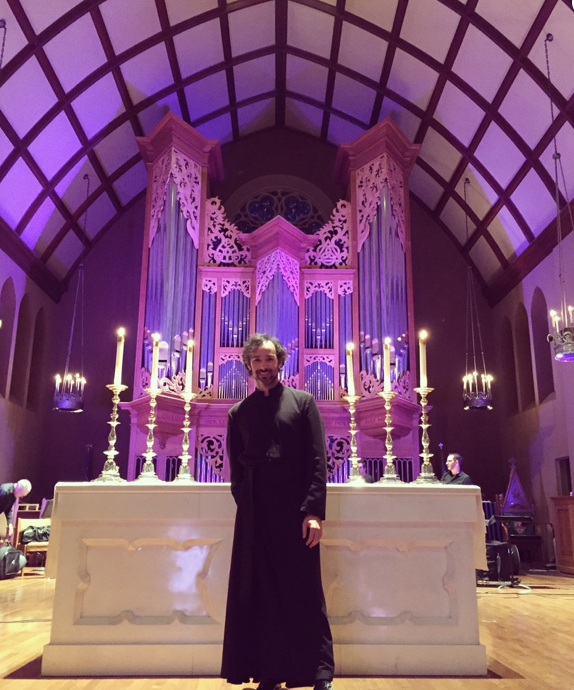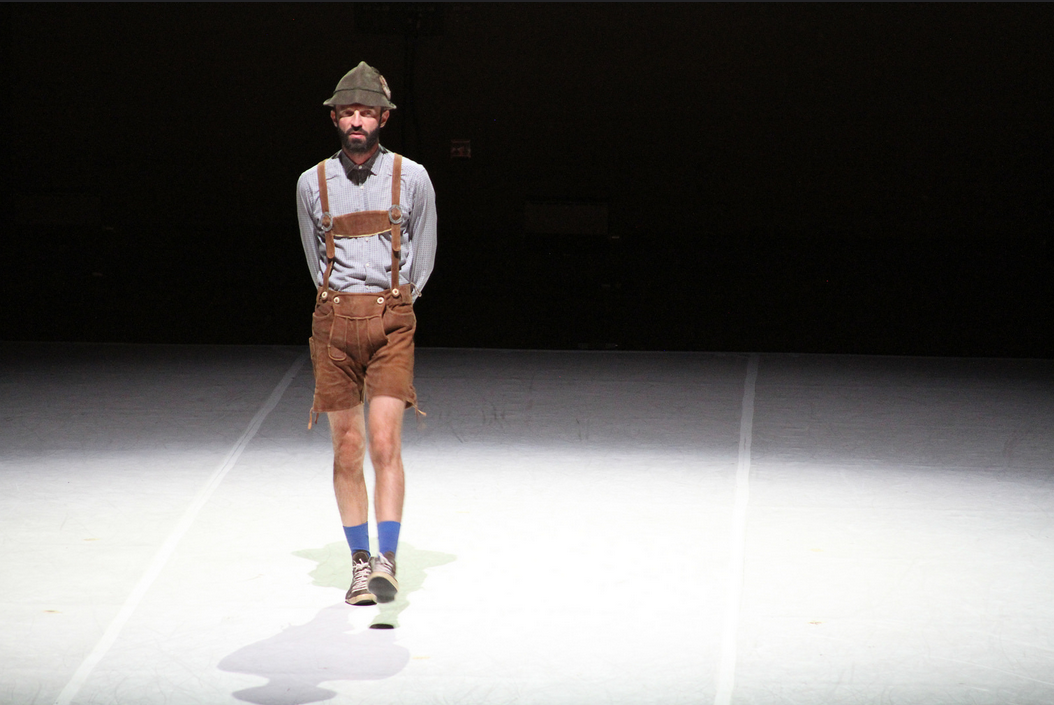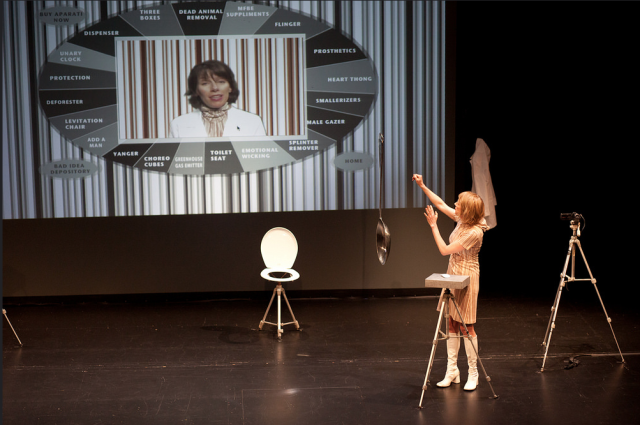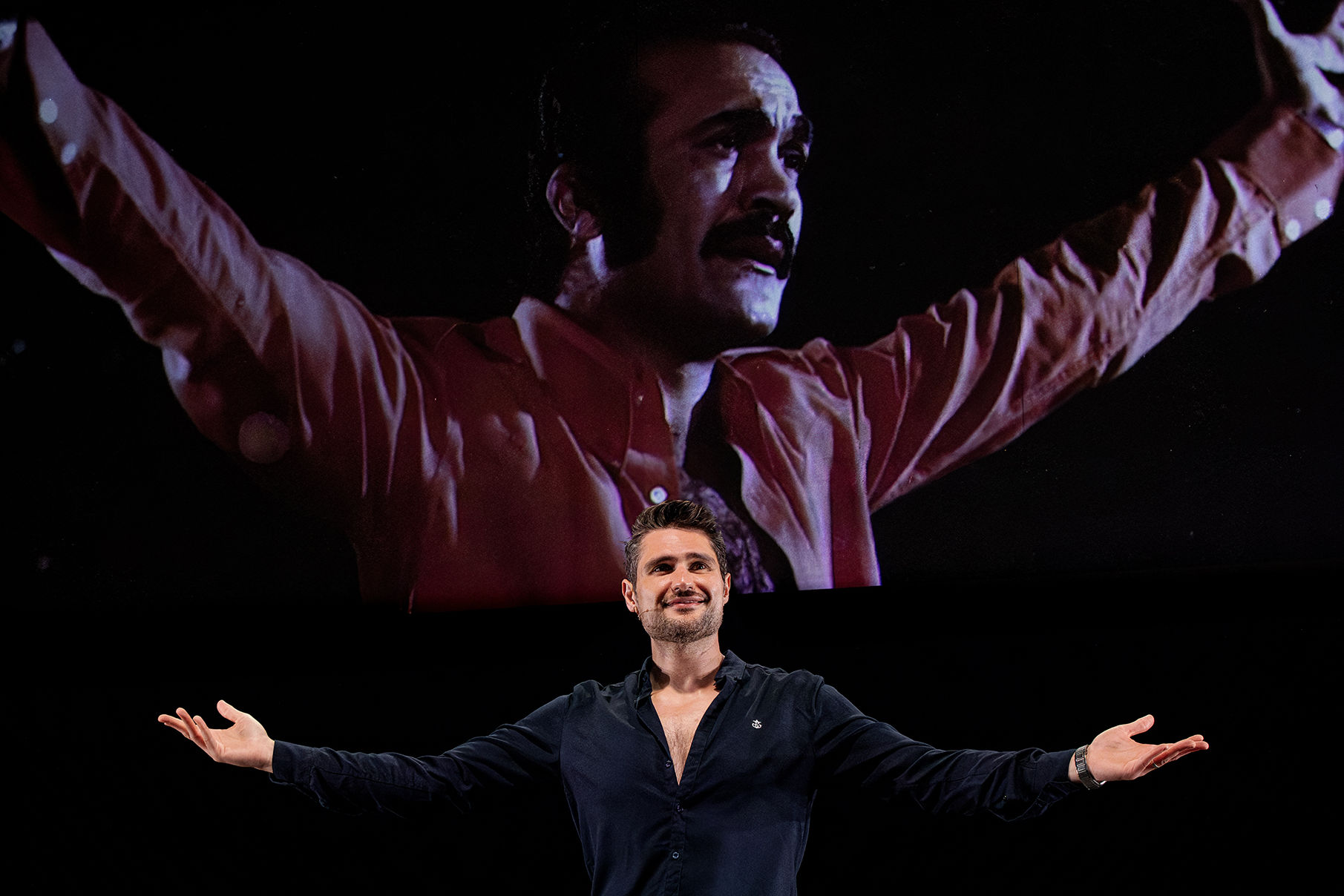The Good, the Bad, and the Cous Cous: Our TBA Recap
It was a ten-day onslaught of art, and the Portland Monthly critics were all over town at art shows, performance pieces, dances, and musical events. Here's the verdict on some of this year's TBA's standout shows.
Holcombe Waller’s Requiem Mass: LGBT/Working Title
Trinity Episcopal Cathedral, September 11, 12

Holcombe Waller's Requiem Mass. Photo by Eden Dawn.
Review: The setting at Trinity Episcopal church, the full-throated purple-clad choir, the audio of past leaders spouting homophobic rhetoric, the pastor at the pulpit’s short sermon on acceptance, the psalm-like responses required to the biographies of the 19 trans women murdered in the US this year alone: Holcombe Waller’s Requiem Mass was a sacred experience dedicated to all those persecuted for their sexual orientation or gender expression.
Critic’s verdict: The best thing I’ve been to in a church. Ever. And I’ve been to Bethlehem. (Eden Dawn)

Alessandro Sciarroni's FOLK-S. Photo by Nawal Alaoui. Courtesy of Portland Institute for Contemporary Art
Alessandro Sciarroni’s FOLK-S Will you still love me tomorrow?
PSU: Lincoln Performance Hall, September 11 and 12.
The Show: This Bavarian dance was a practice in patience, and began with a challenge extended by one of six performers: anyone could leave at any time—audience member or dancer—but once they did, they could not reenter. All this led to an awful lot of uncomfortable shifting for viewers, waiting for the next brave individual to leave as sweat–drenched dancers hopped about in varying formations and exit unexpectedly. A marathon in folk shoes.
Critic's verdict: If you stayed, you were rewarded with a performance that demonstrated the adaptation of culture over time and a transformation so subtle you only recognized it when you found yourself cheering on the dancers in the end. (Megan Haverman)
Lars Jan's Early Morning Opera – The Institute of Memory (TIMe)
Winningstad Theater, September 12, 13
Review: Writer and director Lars Jan’s surrealist semi-autobiographical stage performance about family, privacy, and memory brought despair and humor in equal measure. A room-sized light apparatus that acted, at times, as a halogen-lit ceiling, upright framing device, or illuminated floorplan, supported the ambiguity of Jan’s tale, leaving audiences wondering what was real, what was concocted, and—when the appropriation of memory is in question—how could we ever tell?
Critic's verdict: Audience reception was staggering and, presumably, well-documented... (Brandon Staley)
Aki Onda & Akio Suzuki's ke i te ke
Disjecta, September 14
Review: A day or so before this show—one of the most anticipated at TBA—the news came: visa problems had kept Suzuki out of the country. And so Onda, the younger and greener of this Japanese soundscaping duo, played alone, from inside a ring of hushed onlookers on floor mats and folding chairs, to a nonetheless overcapacity crowd. He wandered (variously, in near-darkness, spastic strobe lighting, and spotlights) among scattered metal plates and transistor radios, rattling crispy flame-retardant fabrics, attaching bells to spinning ceiling rotors, turning knobs to epic levels of feedback and dissonance. It wasn’t an easy night, but at some point (when Onda circled the perimeter, ripping up thick strands of orange duct tape?) the pain became transportive.
Critic's verdict: “Cinema of the ear,” is what Onda calls it. We call it assault by art. (Ramona DeNies)

Michelle Ellsworth's Preparation for the Obsolescence of the Y Chromosome. Photo by Wayne Bund. Courtesy of Portland Institute for Contemporary Art
Michelle Ellsworth's Preparation for the Obsolesce of the Y Chromosome
Winningstad Theater, September 15, 16, 17
Review: Is the Y Chromosome in danger, and if so, how can we prepare for becoming a single sex species? With frenetic, neurotic energy and a heavy dose of humor, Ellsworth took the audience through steps she’s taken to prepare for the possibility of losing men: bottling men smells, creating a giant eyeball to keep her permanently in the male gaze, manufacturing oversize items to make her feel small, to name a few. It’s not all toilet seats and awkward dances, however: Ellsworth ultimately digs deeper to explore loss and the ways we cope with grief.
Critic’s verdict: Ellsworth expertly turns a comic monologue into a profound and personal meditation on loss. Pack your tissues. (Fiona McCann)
Radhouane El Meddeb / La compagnie de Soi, Je danse et je vous en donne à bouffer
The Works at the Redd, September 15, 16
Review: Radhouane El Meddeb’s touching and generous homage to the ritual of food preparation was an exercise in grace. He commanded the stage with a presence at once reverent and wry, playing to every sense as he made a meal for a captive audience, dancing through the ritual of preparation with an emotive and sensual poetry.
Verdict: Engaging, alive, and unfailingly graceful, with the added bonus of a delicious plate of couscous. Food and arts? He knew his audience. (Fiona McCann)
Dynasty Handbag, Good Morning Evening Feelings
Disjecta, September 17

Dynasty Handbag. Photo by ‘Tomas Alfredo Valladares’. Courtesy of Portland Institute for Contemporary Art
Review: Strutting the stage in a bra and spandex—think Molly Shannon's style of physical comedy—Dynasty Handbag owned the show, which she explained was aimed at addressing our FAGS: Fear, anger, guilt, and shame. Doing so involved the charismatic Ms Handbag playing a talk show host, lesbian cook, angry tap dancer, and Broadway star, while "womanhood" was played by a cartoon crotch with googly eyes and a talking vagina. Need we say more?
Critic's verdict: Entertaining, enlightening, engaging—Dynasty Handbag is all hilarity, but between the laughs there's a political message worth paying attention to. Who can ignore a talking vagina, after all? (Eden Dawn)
DakhaBrakha
PSU: Lincoln Performance Hall, September 19
Review: The ethereal music of DakhaBrakha (which lands somewhere between The Knife, Bjork, and a pleasant story whispered in confidence on a bucolic day) wowed audiences in their debut Portland performance with an array of instruments both familiar and alien, and beautiful, eerie vocals to match. Many left wondering what exactly they had experienced, and where to get one of those sweet hats.
Critic’s verdict: The melodic capabilities of DakhaBrakha are unmatched and something to be treasured live. Plus, you know, the hats. (Brandon Staley)
Ingri Fiksdal, Ingvild Langgård and Signe Becker, NIGHT TRIPPER
Starting point: The Works at the Redd, September 19, 20
The Show: A short hike through Forest Park led to a clearing, spotted with stumps dressed in jackets with twigs for arms. Once seated in the natural amphitheater an eerie soundscape built slowly into music as two women in white rotated (dance?) at the center. Two compositions highlighted the gradual transition of dusk to dark, each ending with choral spirits emanating a disembodied harmony from the tree line.
Critic’s verdict: I spent the first 30 minutes wondering when it would “start,” and the last 30 wishing wistfully that our Nordic hosts had taken all of the neat elements about 12 steps farther to create a truly immersive experience. (Megan Haverman)
Karl Larsson with Morgan Ritter, Pascal Prosek, and Container Corps: Commonplace
Thru Oct 11: Thursday & Friday from noon-6:30 pm and Saturday & Sunday from noon to 4 pm at PICA, 2500 NE Sandy Blvd
Review: CthuluCon, the H. P. Lovecraft Film Festival: Portland embraces many wild tributes to the abovementioned neo-Victorian horror writer. There just might be none more abstract than this “sculptural” exhibit from Scandinavian artist Larsson and his collaborators. Commonplace started with a Swedish translation of Lovecraft’s collected story notes, all unfinished, and morphed into a self-printed book of Larsson’s deliberately “formless” poetry. (One of the 207 lines: “This wall is different, from all the others.”) The aim of the book, says Larsson, is overtly political: “If the NSA is scanning all of our sentences, then how can we be free? By speaking in broken sentences.” When he puts it that way, we’re intrigued.
Verdict: We’re sold on the politics of formless art – now sell us on the deeper meaning of that copy machine in the corner. (Ramona DeNies)




